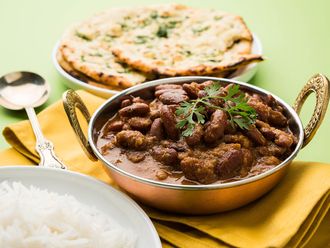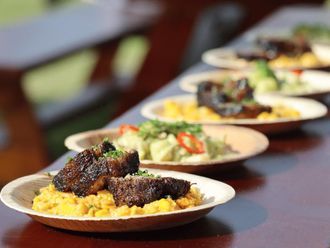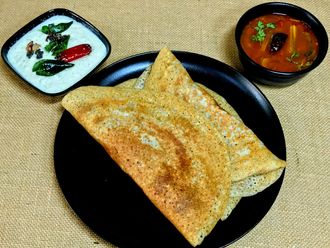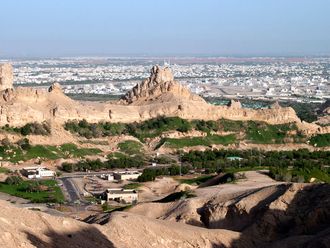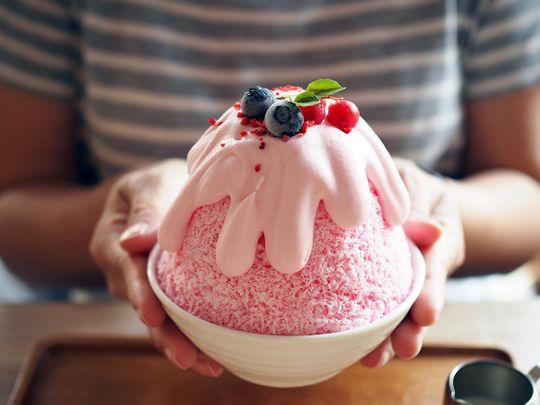
Dubai-based Japanese expat and coffee shop owner, Sayaka Saboya remembers the time she waited as a child in long lines at a depachika, an underground food hall in Japan, in the sweltering summer heat just to get a slurp of ice cold kakigori. “It was worth it. Plus, everyone in Japan grows up with kakigori,” said the 35-year-old, in conversation with Gulf News Food.
As summer begins in the UAE, and the toasty sweaters go back to their places at the very end of your wardrobe, it is time to embrace Japan’s kakigori.
All you need, is a plain block of ice.
A colourful history
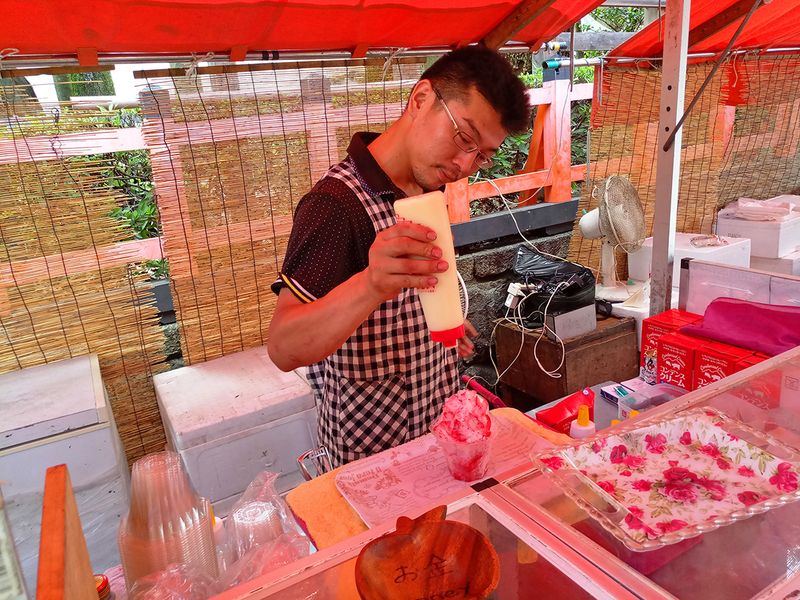
Traditionally made by shaving ice into thin shavings using a sharp blade or knife, the Japanese have perfected the art of making kakigori, ever since it began during the Heian period, which ranged from 794 to 1185 AD.
A dessert dish that began its origins in the royal kitchen of Japan during the reign of the Fujiwara family from 794 AD, kakigori translates to shaved ice soaked or topped with sweet syrup. The very first versions of kakigoris were made from ice blocks that were stored in royal ice houses built on the mountains of Kyoto in Japan. When summer arrived, these ice blocks were transferred to the palace, where it was shaved with a massive hand blade, and stored in metal bowls, topped with sweet sap from vines, ivy and even hydrangeas, before it was served to the emperors.
There were many employed by the royals of Japan to travel the distance to get a block of natural ice, especially in the mountainous regions of Japan. Due to its labour intensive process, kakigori was considered a rarity and were reserved for the Japanese elites. As per an article titled ‘An Avalanche of Japanese Shave Ice’ published in the New York Times on September 17, 2018, “Before the development of freezers, shaved ice was an extravagant dessert reserved only for those who could pay for the luxury of ice carved from frozen lakes and mountains and transported at great cost.”
The Japanese royal kitchens perfected the art of kakigori for 800 years before kakigori reached the common man in Japan. The first stall which exclusively sold kakigori was in Yokohama in 1869, after the first commercial ice-making machine was invented in 1854. Soon after this, ice became readily available and didn’t need to be stored at a remote location. But to perfect a bowl of kakigori, one must perfect the art of shaving ice. “For someone to have light and fluffy kakigori, you must adjust the blade,” explained Saboya. “If you get thin shavings of ice, then it will melt quickly as well.”
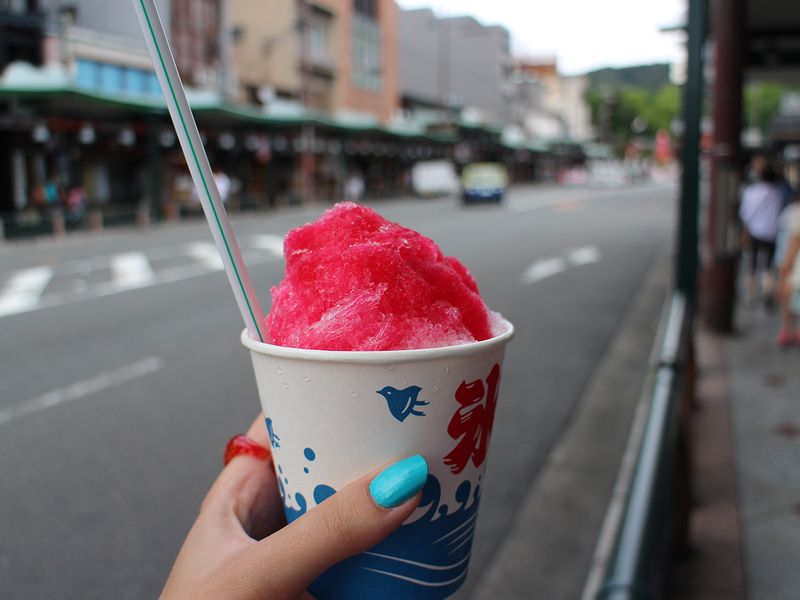
When skilfully prepared, kakigori is all about getting the right ‘crunch’. “But, it must be light, and has to dissolve as quickly as you put it in your mouth.”
Today, kakigori is prepared using automatic ice shavers that come with adjustable blades, and Saboya is the owner of a portable one at her home in Dubai. “It’s quite hard to find a good bowl in Dubai, so I bought an ice shaver from Japan and now I make it at home.”
Often eaten during the summer festival of Matsuri, held in Japan from July through August to mark the beginning of the summer season, the modern-day kakigori is primarily made with condensed milk and sugar syrups. However, you can also opt for a healthier version, as it is easily adaptable and can have any number of combinations. “Since kakigori is a huge part of our childhood, I ensure that my kids don’t miss out on it. But, I give a healthier version at home.

“In fact, my mum used to make it with her father when she was small, and they used to eat it during the summer time. My dad, on the other hand, didn’t make it at home – but he used to carry a large bowl and 50 yen (Dh1.50) to get a bowl full of kakigori from the shop, and eat it with his siblings when they were small. So, like I said, no childhood is every complete without kakigori.”
For another 35-year-old Japanese expatriate in Dubai, Maki Kosaka, a homemaker, kakigori brings fond memories of summer in Japan as well. “I don’t remember the first time I had kakigori, but I used to eat it quite a lot during Matsuri, the Japanese summer festival. I also remember, I had a machine at home, and we made it almost every day during the summer, when I was a child. Today, they have a lot of different syrup flavours, but the best part of it all is that the ice shaving machine is much easier to use now, and you can eat ice in any form, especially like snow.”
While the Japanese are the original creators of this dish, they also were the ones who made it popular the world over.
A dessert for the world over

Korea’s bingsu, Hawaii’s shaved ice, Taiwan and China’s bao bing, Philippines’ halo-halo, and India’s chuski, are some of the other popular versions of the dessert. The dessert’s popularity began when Japanese plantation labourers migrated to Hawaii, and prepared the dessert during the summer. From Hawaii, it reached the rest of the world, in different names; some even with a whole new avatar.
Bingsu, is ubiquitous in Korea so much that it is served in popular fast-food franchises as well. However, unlike kakigori, which relies primarily on ice, bingsu is more about the toppings. The ice, resembles a snowball and uses red beans, condensed milk, tteok or rice cakes, as popular toppings. Some would even add ice cream to enhance the flavour a little more.
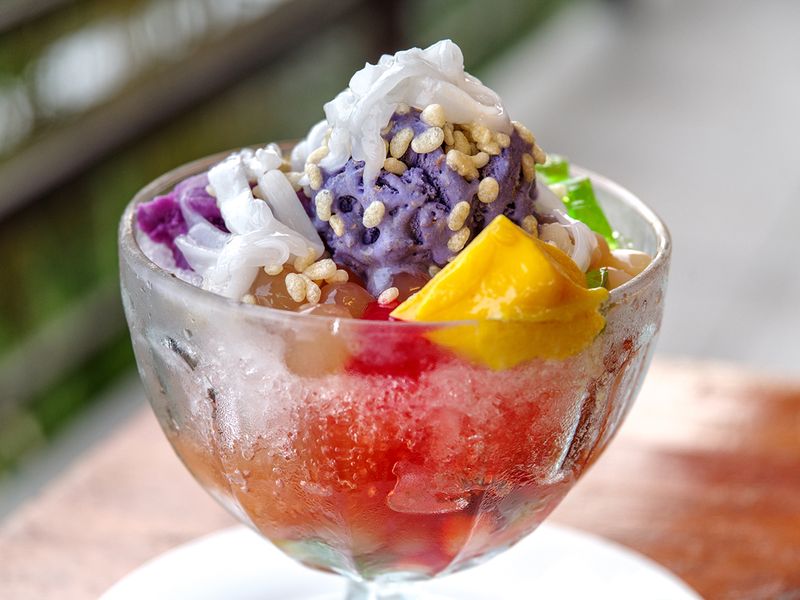

Every kid loves it, so do adults but it’s more of an acquired taste. Personally I feel that in Dubai, very few places match up to the halo-halo of my childhood.
For those in the Philippines, halo-halo is the perfect way to chill out on a hot summer’s day. “When I was small, my siblings and I – we were a group of 6 – used to spend our summers shaving ice with our grand mum. We would shave ice, eat halo-halo, go play outside, come back and repeat the whole process. Every kid loves it, so do adults but it’s more of an acquired taste. Personally I feel that in Dubai, very few places match up to the halo-halo of my childhood,” said 40-year-old Dubai-based Filipino expatriate Olga Barcelona, who works as the Head of Operations in a media company.
Halo-halo uses quite a large amount of ingredients in its preparation. “Some use fresh milk, some use evaporated milk. We add sweetened plantains, sweet potatoes, jackfruits, coconut, tapioca pearls which are known as sago, leche flan and ube, a jam made from purple yams, coconut milk and butter, as well. It is heavily coloured and it’s all about the sweet flavouring.”
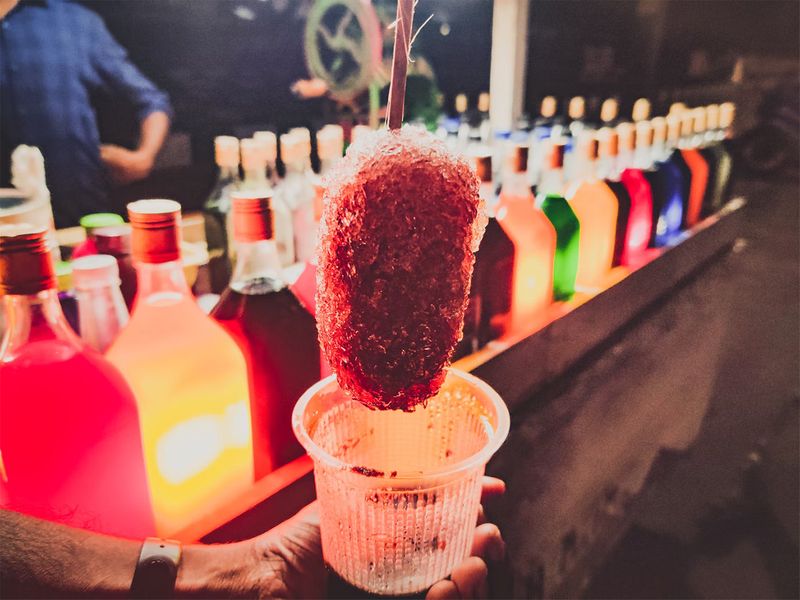

It’s just the perfect dessert to make memories with, especially during the summer when the heat can really get to you
India’s chuski isn’t too far behind as well. Made only with two ingredients – sugar syrup and crushed ice – gola or chuski is a street food favourite. “When in India, baraf ka gola is a must. I come from Mumbai, and they have some of the best golas over there. It’s almost as if no feeling in the world, could ever replicate it – especially because you are home, the city is perfect and the weather would be really hot. I haven’t gone back in a while, but luckily, Dubai’s got everything you need. It’s quite rare to find something that matches the one you get back in India, but there’s a restaurant in Al Karama which serves the best gola, according to me. I went there before the pandemic with my friends – and it is such a fond memory of mine – because we went there as a group, and each one of us tried every flavour at the restaurant… almost got a frozen jaw, but it was worth it. I think I’d definitely go back just for the rose-flavoured gola and the kala khatta flavour. It’s just the perfect dessert to make memories with, especially during the summer when the heat can really get to you,” said 27-year-old Prerna Manchharamani, a Dubai-based Indian expat who works as an insurance broker.
As temperatures rise in the UAE, and summer winds take over the city, kick back with a bowl of kakigori or any shaved ice dessert from around the world and chill out. Here are two recipes for Japanese kakigori and Korean bingsu.
Cream cheesecake Kakigori
Sayaka Saboya, Japanese expatriate based in Dubai
Preparation time: 10 minutes
Cooking time: 0
Serves: 2 to 3
Ingredients:
50 gms cream cheese
50 gms Greek yoghurt
20 gms sugar
60 ml water
Method:
Combine and mix the ingredients well.
Freeze it in a mould. Note: If you are using a Kakigori maker, the mould is included. If not, transfer to a mould of your choice and freeze.
Once frozen, set the mix in the kakigori maker or blender and crush to preferred texture.
Serve and enjoy!
Matcha Bingsu recipe
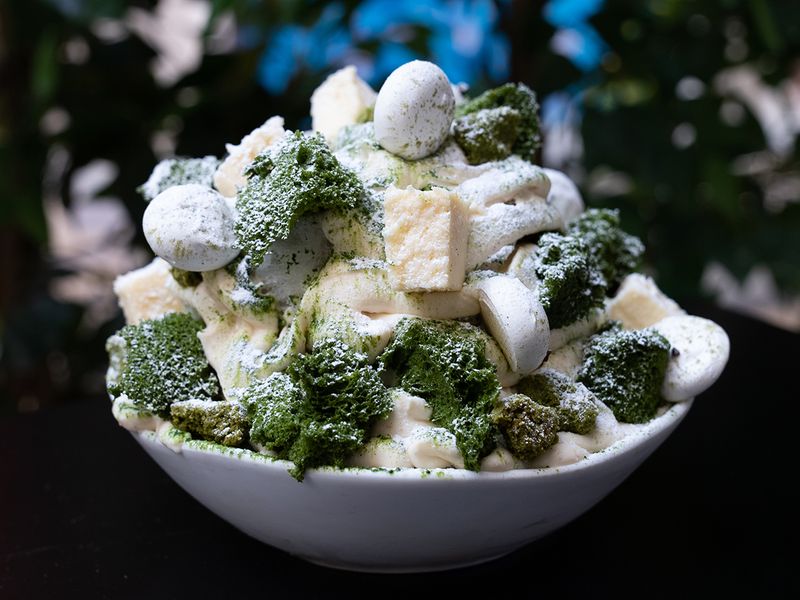
Chef Jin Chul Kim, Head Chef at Kojaki, Expo 2020 Dubai
Preparation time: 30 minutes
Cooking time: 2 hours 20 minutes
Serves: 2 to 3
Ingredients:
Matcha spread
180 ml fresh cream
1 gms caster sugar
10 gms trimoline (invert sugar)
1 piece gelatine leaf
150 gms white chocolate
300 ml fresh cream
40 gms Matcha tea powder
White chocolate cheesecake
100 gms cream cheese
2 gms vanilla essence
40 gms caster sugar
30 gms whole egg
60 gms white chocolate
30 gms creme fraiche or soured cream
Matcha syrup
100 ml water
200 gms caster sugar
30 gms matcha tea powder
Baked meringue
100 gms egg white at room temperature
200 gms caster sugar
Pink peppercorn skin, as needed
Cocoa nibs, as needed
Matcha ice cream
200 ml milk
100 ml fresh cream
4 pieces egg yolk
1 whole egg
60 gms caster sugar
20 gms matcha tea powder
Matcha crumble
100 gms almond powder
100 gms caster sugar
100 gms all-purpose flour
100 gms soft butter
2 egg yolks
To plate Bingsu:
Ice
Condensed milk
Matcha tea powder
Method:
1. For the matcha spread, boil 180 ml of cream with both sugars and pour the mix over the green tea powder. Let it infuse, and then add white chocolate. Mix well until dissolved. Add pre-soaked and melted gelatine leaf into it. Lastly, add 300 ml of boiled fresh cream. Set and rest overnight before use.
2. For the cheesecake, combine egg, sugar and whisk until the mix builds volume and the sugar is dissolved. Keep aside.
3. In another bowl, add vanilla essence and melted chocolate. Whisk on high speed. Bring the speed down to a low while adding the soured cream. Pre-heat oven at 180C, line a tray with baking paper, pour the mixture and reduce heat to 165C. Bake for 30 minutes and let it cool. Store in an air tight container and leave it to rest in a freezer.
4. For the matcha syrup, combine water and sugar; boil it. Add the tea powder and mix well; let it boil again. Strain and let it cool before use.
5. For the meringue, whisk together egg white and sugar in a large bowl until stiff peaks.
6. Pipe in desired shape and sprinkle pink peppercorn skin and cocoa nibs as required. Bake in batches, with the first batch at 120C for 30 minutes and another batch for 1 hour 30 minutes at 100C. Let it cool.
7. For the matcha ice cream, combine milk and fresh cream in a saucepan. Bring it to a light boil. In the same bowl, mix eggs and sugar, until dissolved. Cook on a low flame until it reaches 85C in temperature. Remove it from the flame, and let it cool. Give it an ice bath to gradually stop the cooking process. Add green tea powder and blend. Strain and set overnight before churning process. As an alternative, you can also use store-bought matcha ice cream.
8. For the matcha crumble, combine the ingredients in a bowl and mix it in a blender on a low speed, until smooth. Evenly spread the crumble mix in a container and bake at 165C until it turns light brown in colour. Take it out of the oven and crush it. Let it cool aside and store in an air tight container.
9. To plate the Bingsu, scoop a generous amount of ice, top with with the matcha spread, cheesecake, meringue, a scoop of matcha ice cream, matcha crumble and matcha syrup. Add condensed milk and sprinkle matcha powder. Serve and enjoy!
Share your food stories and recipes with us on food@gulfnews.com



